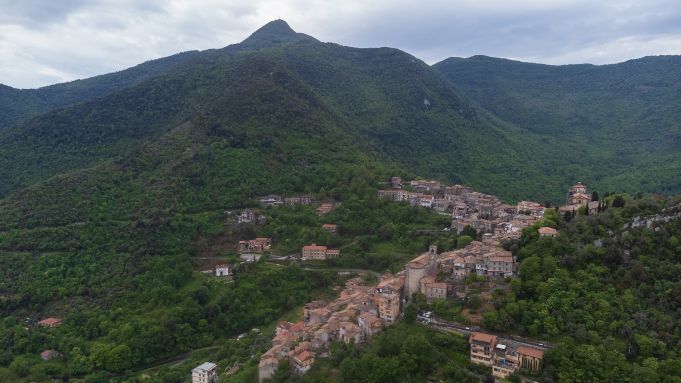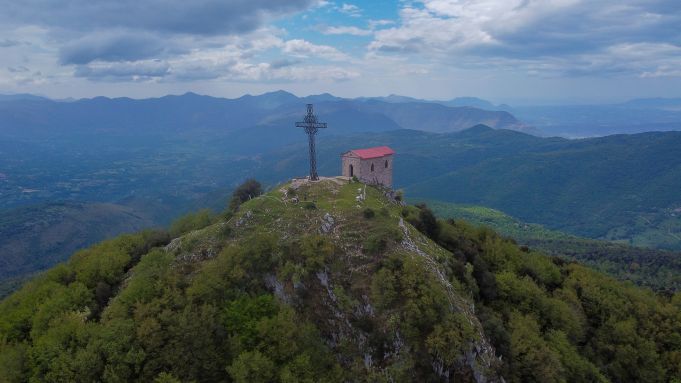Dante's Peak in Ciociaria: Discovering Patrica and Monte Cacume.
The year 2021 witnessed a flurry of events centred on the 700th anniversary of Dante’s death and a small, inconspicuous town in the historic region of Ciociaria south of Rome chose to celebrate its very own, small connection with “il Sommo Poeta”.
Patrica rests, partly hidden from sight, on a hill that descends gently from the eastern edges of the Lepini mountains, overlooking the Sacco valley and in the shadow of Monte Cacume. This conical peak, though modest in height – its altitude is just under 1,100 metres – is visible from afar and it is crowned by a 14-metre high steel cross placed there in 1903 by the inhabitants of Patrica in honour of the Jubilee year of 1900, which took place during the papacy of Leo XIII (a selection of pictures on display in the chapel on the mountain documents the local inhabitants’ efforts).
However, this curious feature is not the main reason why the mountain is unusual, after all there are crosses of all shapes and sizes on most Apennine peaks, but rather because scholars believe that Dante, who travelled through Ciociaria and mentions other places in the region (such as Anagni), cites this specific peak in the following verses of Purgatory (IV, 25-27):
“Vassi in Sanleo e discendesi in Nolli;
montasi su in Bismantova e in Cacume con esso i piè;
ma qui convien che omo voli”.
In these verses, Dante compares the steep trail that he walked with Virgil on his journey to Purgatory – a feeling with which any amateur hiker can empathise – with the difficult ascent to four distinct locations, among which he lists Monte Cacume.
Dante visited Ciociaria at the very least on two occasions, in 1294 and in 1301 when he was a member of a Florentine delegation that paid homage to Pope Celestine V (the pope of the Great Refusal) and Pope Boniface VIII (the pope of the Anagni Slap) and it is likely that the mountain peak left an impression on the poet.

However Dante would have not found today’s marked trail so demanding as it is a moderate one that departs from Patrica and can be completed in three hours. More ambitious hikers can follow several other trails that lead deeper into the Lepini mountains (unfortunately, not a protected area yet) and are described in Stefano Milani’s recent Italian-language guide, Monti Lepini. Guida Escursionistica.
If you find yourself, however, out of breath – after all there is an elevation gain of almost 700 metres to be tackled – you can save face by halting at the many statues made of weathering steel that dot the trail. Each statue, created by local artist Cesare Pigliacelli and installed by volunteers from the local association L’Orchidea di Patrica, represents character described in Purgatory – though their punishments are not as exciting as those reserved for the dwellers in Hell – along with the verses that accompany that character’s story.
As you ascend past the different terraces of Purgatory, leaving behind great names such as Manfred of Swabia or Barbarossa, you find yourself, symbolically, closer to Paradise and upon reaching the peak, with views that reach as far as the Pontine archipelago, the climax is the fateful encounter that marks Dante’s next journey: you can discover who that is for yourselves!

The mountain has a curious geological history; it is partly a klippe, an isolated residue of an older carbonate layer located, as a result of tectonic movements, on top of more recent waterproof clay layers. This is the reason why there are so many springs along the poorly marked trail that circumambulates the peak which requires an additional 30-40 minutes and why the area is such a botanical treasure trove with dozens of wild orchid species (visit in May and early June and you’ll be rewarded with a treasure trove of wildflowers).
Also, keep an eye out for the sparse ruins of the mediaeval Benedictine monastery and the fortified settlement known as the Castrum Cacuminis that once stood on the mountain: a seemingly impregnable position.
If you plan your hike in the early morning or in the early afternoon, you should include a light meal at the only restaurant in the old town, the small and delightful Comedia Bistrot (book in advance), or stop off at the local pasticceria Ricordi Lievitati.
It is also strongly recommended exploring the old town: try to spot the mysterious symbols that appear on the keystones of several stone portals and observe, discreetly, the unusual figures that decorate the secluded Giardino all’Italiana of the 16th-century Palazzo Spezza, named after a noble family of Spanish origin that has owned the palace since the 18th century.
By Jan Claus Di Blasio
HOW TO GET TO PATRICA
Patrica is best reached by car from the Ferentino exit on the A1 motorway, however there are limited Cotral bus connections from Frosinone train station for those without a car.
Photography tip: the best viewpoint over the town of Patrica is located by the statue of Belacqua, a minor character from the Divine Comedy who was punished for his indolence and laziness!
This article was published in the July-August 2022 edition of Wanted in Rome magazine.
General Info
View on Map
Exploring Patrica on a day trip from Rome
03010 Patrica, Province of Frosinone, Italy





















